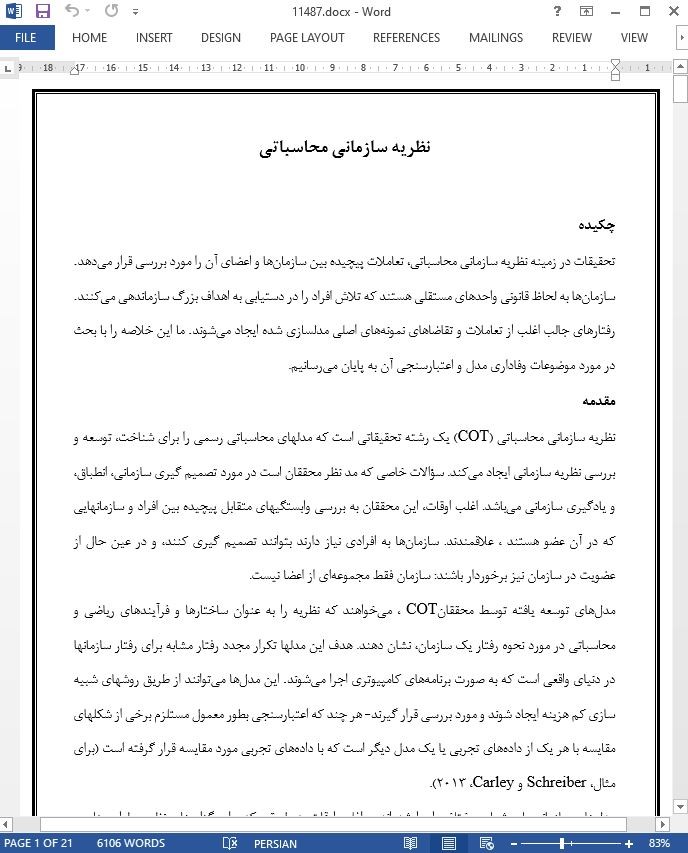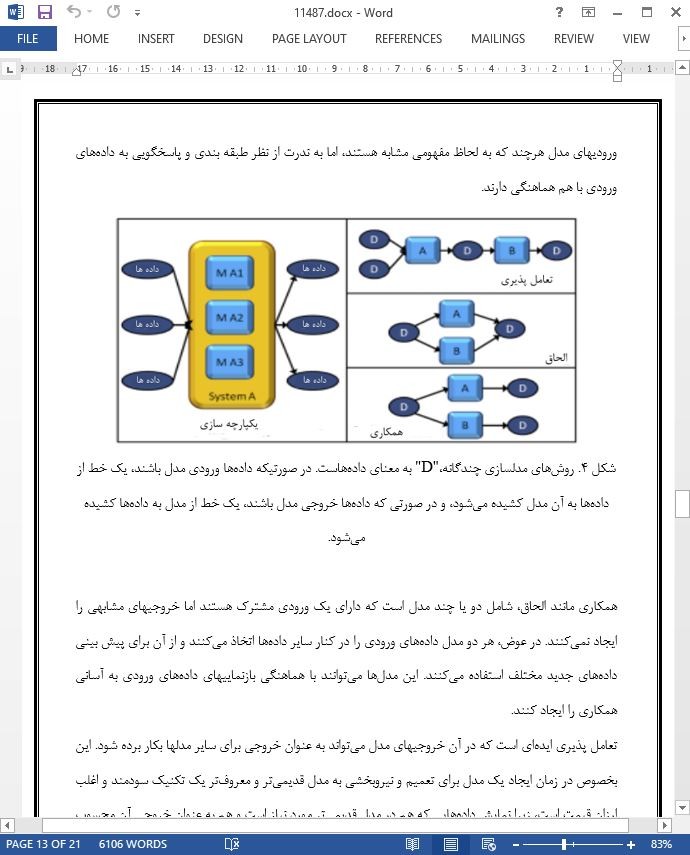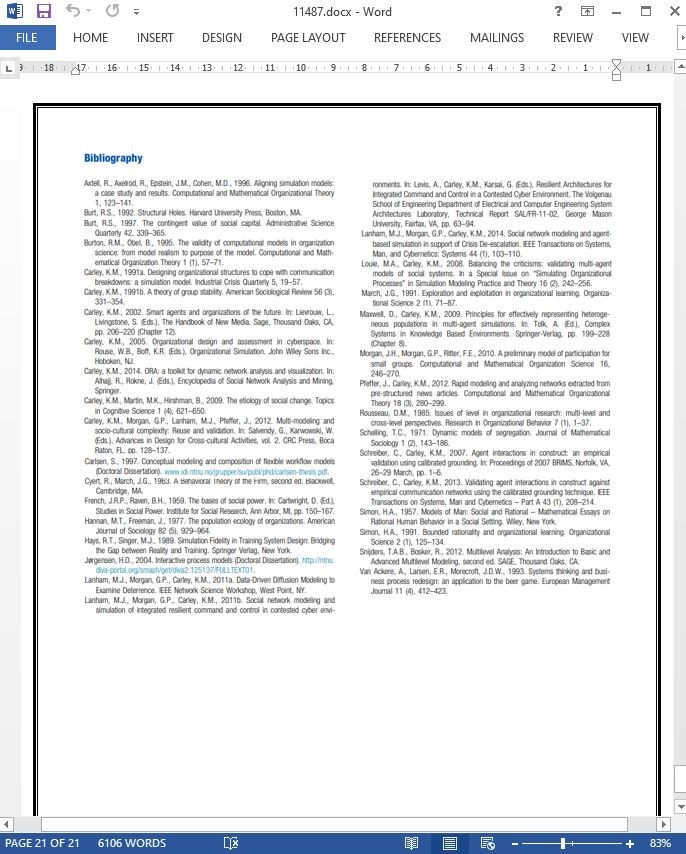
نظریه سازمانی محاسباتی
چکیده
تحقیقات در زمینه نظریه سازمانی محاسباتی، تعاملات پیچیده بین سازمانها و اعضای آن را مورد بررسی قرار میدهد. سازمانها به لحاظ قانونی واحدهای مستقلی هستند که تلاش افراد را در دستیابی به اهداف بزرگ سازماندهی میکنند. رفتارهای جالب اغلب از تعاملات و تقاضاهای نمونههای اصلی مدلسازی شده ایجاد میشوند. ما این خلاصه را با بحث در مورد موضوعات وفاداری مدل و اعتبارسنجی آن به پایان میرسانیم.
مقدمه
نظریه سازمانی محاسباتی (COT) یک رشته تحقیقاتی است که مدلهای محاسباتی رسمی را برای شناخت، توسعه و بررسی نظریه سازمانی ایجاد میکند. سؤالات خاصی که مد نظر محققان است در مورد تصمیم گیری سازمانی، انطباق، و یادگیری سازمانی میباشد. اغلب اوقات، این محققان به بررسی وابستگیهای متقابل پیچیده بین افراد و سازمانهایی که در آن عضو هستند ، علاقمندند. سازمانها به افرادی نیاز دارند بتوانند تصمیم گیری کنند، و در عین حال از عضویت در سازمان نیز برخوردار باشند: سازمان فقط مجموعهای از اعضا نیست.
خلاصه
در این مقاله، ما حوزه COT را معرفی کردهایم. تحقیقات در خصوص COT به بررسی تعاملات پیچیده بین سازمانها و اعضای آن میپردازند. رفتارهای جالب، اغلب از تعاملات و خواستههای نمونههای ابتدایی مدل سازی شده، خواه افراد و خواه فرآیندها، پدیدار میشوند، هر چند که این مقدمه بر شبیه سازی مردم محور تمرکز دارد.
ما سازمانها را به عنوان نهادهای مستقل قانونی تعریف کردیم که با ظرفیتی فراتر از ظرفیت هر یک از اعضا در دستیابی به اهداف تلاش میکند. پیگیری سازمان برای اهداف خود، هم سازمان و هم محیطی که در آن فعالیت دارد را تغییر میدهد، که میتواند تأثیر سودمند یا معکوسی بر سازمانها (خودشان) داشته باشد. اعضای یک سازمان وظایف خود را انجام میدهند و برای انجام این وظایف هم به دانش نیاز دارند و هم آن را تولید میکنند.
Abstract
Research in computational organizational theory explores the complex interactions between organizations and their members. Organizations are legally autonomous entities that structure the efforts of individuals to achieve large goals. Interesting behavior often emerges from the interactions and demands of modeled primitives. This introduction describes the common ground and recent advances in multimodeling, multilevel modeling, and rapid model development. We conclude this summary with discussion of issues of model fidelity and model validation.
Introduction
Computational organization theory (COT) is a research discipline, which develops formal computational models to understand, extend, and examine organizational theory. Specific questions of interest to researchers in this field include organizational decision making, adaptation, and organizational learning. Often, these researchers are interested in the complex interdependencies between individuals and the organizations of which they aremembers.Organizations needindividuals tomake decisions, yet individuals benefit from membership in an organization: the organization is not merely the sum of its members.
Summary
In this article, we have introduced the area of COT. Research in COT explores the complex interactions between organizations and their members. Interesting behavior often emerges from the interactions and demands of modeled primitives, whether people or processes, although this introduction has focused on people-oriented simulation.
We have defined organizations as legally autonomous entities that attempt to achieve goals not within the capacity of any individual member. An organization’s pursuit of its goals will change both the organization and the environment in which it operates, affecting other organizations (and themselves) either beneficially or adversely. Members of an organization do tasks, and both require and generate knowledge in the performance of these tasks.
چکیده
مقدمه
سازمان چیست؟
تعریف یک شبیه سازی چندعامله
بازنماییهای زمان
بازنماییهای فضا
عناصر محیطی
عوامل
دانش
وظایف
تحقیقات کنونی
مدلسازی چندگانه و تعامل مدل
مدلسازی چندسطحی
توسعه سریع مدل
وفاداری مدل و اعتبارسنجی آن: نگرانیهای مشترک
وفاداری مدل
اعتبار سنجی مدل
خلاصه
Abstract
Introduction
What is an Organization?
Defining a Multiagent Simulation
Representations of Time
Representations of Space
Elements in the Environment
Agents
Knowledge
Tasks
Current Research
Multimodeling and Model Interaction
Multilevel Modeling
Rapid Model Development
Model Fidelity and Model Validation: Common Concerns
Model Fidelity
Model Validation
Summary
- اصل مقاله انگلیسی با فرمت ورد (word) با قابلیت ویرایش
- ترجمه فارسی مقاله با فرمت ورد (word) با قابلیت ویرایش، بدون آرم سایت ای ترجمه
- ترجمه فارسی مقاله با فرمت pdf، بدون آرم سایت ای ترجمه



